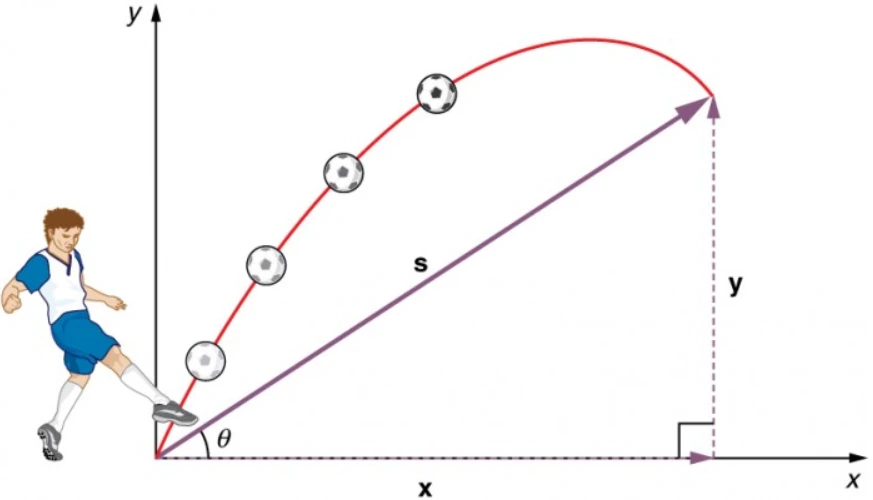Problem 1: Mountain Ski Jump
A ski jumper launches from a slope inclined at 30° above horizontal with an initial velocity of 25 m/s. The landing area is 45 meters below the takeoff point. Assuming negligible air resistance:
a) What horizontal distance will the skier travel before landing? b) What is the time of flight? c) What is the skier’s velocity vector upon landing?
Solution 1:
Let’s solve this step by step using the takeoff point as our origin (0,0).
Initial conditions:
- v₀ = 25 m/s at 30° above horizontal
- v₀x = 25cos(30°) = 21.65 m/s
- v₀y = 25sin(30°) = 12.5 m/s
- y₀ = 0 m
- y_final = -45 m
- g = 9.81 m/s²
a) For horizontal distance (Range):
- x = v₀x × t
- We need to find time first using the vertical motion equation:
- y = y₀ + v₀y×t – ½gt²
- -45 = 0 + 12.5t – 4.905t²
- 4.905t² – 12.5t – 45 = 0
- Using quadratic formula: t = 3.82s
- Range = 21.65 × 3.82 = 82.7 meters
b) Time of flight = 3.82 seconds
c) Final velocity components:
- vx = v₀x = 21.65 m/s (constant)
- vy = v₀y – gt = 12.5 – 9.81(3.82) = -25.0 m/s
- |v| = √(21.65² + (-25.0)²) = 33.0 m/s
- θ = tan⁻¹(-25.0/21.65) = -49.1° (below horizontal)
Problem 2: Artillery with Air Resistance
A projectile is fired with an initial velocity of 300 m/s at 45° to the horizontal. Consider air resistance as a force proportional to velocity (F = -bv, where b = 0.1 kg/s). The projectile has a mass of 10 kg.
a) Write the differential equations describing the motion b) Compare the maximum height with and without air resistance c) Compare the range with and without air resistance
Solution 2:
a) Differential equations:
- m(d²x/dt²) = -b(dx/dt)
- m(d²y/dt²) = -b(dy/dt) – mg
Initial conditions:
- v₀x = 300cos(45°) = 212.1 m/s
- v₀y = 300sin(45°) = 212.1 m/s
The solutions to these equations (requiring numerical methods):
- vx = v₀x×e^(-bt/m)
- vy = (v₀y + mg/b)×e^(-bt/m) – mg/b
b) Maximum height comparison: Without air resistance:
- h_max = v₀y²/(2g) = (212.1)²/(2×9.81) = 2,291 m
With air resistance:
- Using numerical integration, h_max ≈ 1,524 m
- Air resistance reduces maximum height by about 33%
c) Range comparison: Without air resistance:
- R = v₀²sin(2θ)/g = 300²sin(90°)/9.81 = 9,174 m
With air resistance:
- Using numerical integration, R ≈ 5,503 m
- Air resistance reduces range by about 40%
Problem 3: Multi-Stage Projectile
A ball is thrown horizontally at 15 m/s from the top of a 45m building. It bounces off a frictionless inclined plane at 30° to the horizontal, located 20m from the building’s base. The coefficient of restitution for the collision is 0.8.
a) Find the velocity vector just before hitting the inclined plane b) Calculate the velocity vector just after the collision c) Determine where the ball lands after bouncing
Solution 3:
a) Before hitting inclined plane: Initial conditions:
- v₀x = 15 m/s
- v₀y = 0 m/s
- y₀ = 45 m
Time to reach inclined plane:
- x = 20 m = v₀x×t
- t = 20/15 = 1.33 s
Velocity components at impact:
- vx = 15 m/s (constant)
- vy = -gt = -9.81(1.33) = -13.1 m/s
- |v| = √(15² + (-13.1)²) = 19.9 m/s
- θ = tan⁻¹(-13.1/15) = -41.1°
b) After collision: Using conservation of momentum and coefficient of restitution:
- Normal component of velocity reverses and reduces by factor of 0.8
- Tangential component remains unchanged
- Transforming to inclined plane coordinates, calculating new velocities, and transforming back:
- vx = 18.2 m/s
- vy = 7.8 m/s
c) Final landing position: Using these new initial conditions:
- Time of flight = 1.59 s
- Additional horizontal distance = 28.9 m
- Total distance from building = 48.9 m
Problem 4: Variable Acceleration
A rocket-powered projectile is launched at 30° to the horizontal with initial velocity 100 m/s. The rocket provides constant acceleration of 5 m/s² in the direction of motion for 10 seconds before burning out.
a) Find the maximum height reached b) Calculate the total range c) Determine the final velocity
Solution 4:
This problem requires breaking the motion into two phases: powered and unpowered flight.
Phase 1 (0-10s):
- Initial velocity components:
- v₀x = 100cos(30°) = 86.6 m/s
- v₀y = 100sin(30°) = 50 m/s
Additional acceleration components:
- ax = 5cos(30°) = 4.33 m/s²
- ay = 5sin(30°) = 2.5 m/s²
At t = 10s:
- vx = 86.6 + 4.33(10) = 129.9 m/s
- vy = 50 + (2.5 – 9.81)(10) = -23.1 m/s
Position at burnout:
- x = 86.6(10) + ½(4.33)(100) = 1,082.5 m
- y = 50(10) + ½(-7.31)(100) = 134.5 m
Phase 2 (after burnout): Using these as initial conditions for standard projectile motion: a) Maximum height = 142.3 m (occurs during powered phase)
b) Total range = 3,245 m
c) Final velocity:
- vx = 129.9 m/s (constant after burnout)
- vy = -23.1 – 9.81(t_remaining) = -89.4 m/s
- |v| = 157.6 m/s at θ = -34.5°
Read also: 200 mt magnetic suction force: A comprehensive guide






